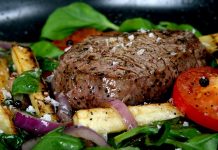WASHINGTON, DC - Researchers studying the diet-cancer link are devoting a new level of scientific attention to a dietary factor that many people take for granted - variety. As studies involving single foods or food components often fail to uncover strong protective associations, scientists around the world are turning to approaches that can reliably track the complex protective interactions taking place in the overall diet.
According to researchers at the American Institute for Cancer Research (AICR) 11th Annual Research Conference, the renewed focus on variety in the diet was spurred by many factors. New methods and technologies are allowing scientists to track multiple influences and effects at the same time, and in a more precise fashion than ever before. Meanwhile, evidence that foods interact to provide extra health benefits (a concept that has come to be known as synergy) has been building steadily for years.
Finally, the scientists expressed concern that studying individual foods and isolated food components has left the public with mistaken impressions about the diet-cancer connection.
"A diet is more than the sum of its parts, and you can often be misled by breaking the diet into artificial pieces such as carbohydrates, proteins and fats," said conference speaker Dr. David Heber of the UCLA Center for Human Nutrition. "We eat foods, not just nutrients, and there is overwhelming evidence that eating up to a pound of diverse fruits and vegetables can markedly reduce the risks of common forms of cancer and other diseases."
Lack of Variety Linked to Increased Risk of Disease
Studies that compare the diet and disease rate of different populations have long shown that risks of cancer and other diseases are substantially lower in countries where diets high in a variety of vegetables, fruits and whole grains are the norm. For decades, researchers have been seeking to identify the precise factors in such diets that offer protection. But this, Heber said, is a daunting task, because diets that include such a rich diversity of plant foods provide over 25,000 different phytochemicals.
"Moreover, there are 150,000 to 200,000 different edible plant foods in the world, and most Americans eat only three per day," said Dr. Heber. "Compare that to existing hunter-gatherer populations eating over 800 varieties of plant foods. We have a long way to go to increase the diversity and amount of plant foods in the American diet."
As science on the diet-cancer link progresses, more and more foods and food substances are showing cancer-fighting potential. It is becoming clear to researchers that the search for "magic bullets" - single substances or foods that prevent many kinds of disease throughout the body - may be doomed to failure.
"We need to stop treating fruits and vegetables as if they were drugs," said Dr. Heber. "Every vegetable and fruit has a unique profile of nutrients and phytochemicals, and these families of compounds exert beneficial effects on our bodies to prevent disease."
To illustrate his point, Heber cited the results of recent studies that go beyond the well-known antioxidant properties of fruits and vegetables. Tomatoes and tomato-based products, he said, are a rich source of lycopene, which becomes concentrated in the prostate gland where it seems to normalize prostate cell function and inhibit prostate cancer growth.
Spinach, avocado and other yellow or leafy green vegetables contain lutein. Heber presented new findings at the AICR conference showing that lutein concentrates in the retina and the lens where it reduces the risk for cataracts and macular degeneration, the leading preventable cause of blindness in America, which affects 13 million people. Surprisingly, he said, lutein also slows prostate cancer cell growth. And when it is combined with lycopene, lutein demonstrates independent and additive preventive effects on prostate cancer cell growth.
"These examples are only the beginning," he said. "There are hundreds, perhaps thousands of such substances in vegetables and fruits that stimulate the metabolic pathways of genes in different organs to provide protection against cancer and other diseases. After all, cancer is not one disease but many, and no single food or compound can provide the different kinds of cells in the body with the unique kind of protection they require. That means that beyond eating five to nine servings of fruits and vegetables a day, you need to ensure that you're getting a diverse array of these foods."
In fact, surveys show that most Americans are not even eating five servings a day - unless you count snack foods. Heber cited studies showing that the average American's total intake of fruits and vegetables is about three servings a day. "That boils down to two vegetables and a fruit," he said. "And if those three servings consist of iceberg lettuce, French fries and a little ketchup for color, you're in big trouble."
To Add Variety, Use Color as a Cue
Health professionals have historically used many different strategies to urge people to increase the variety in their diets. The once-prevalent "Four Food Groups" gave way, in 1992, to the FDA Food Guide Pyramid, which has been adapted to different populations over the years.
Last year, the American Institute for Cancer Research launched a new educational program called "The New American Plate," which calls for Americans to shift the proportions on their plates for lower weight and better health. By emphasizing how healthy proportions will look on the plate ("two-thirds or more vegetables, fruits, whole grains and beans; one-third or less animal protein") and offering recipes that emphasize the flavors, colors and textures of plant foods, the New American Plate has helped thousands of people consume a more varied and healthy diet.
This summer, Dr. Heber has thrown his own hat in the ring with his new book, "What Color is Your Diet?" (ReganBooks/Harper Collins, 2001) In the book, Heber groups vegetables and fruits by the colorful and beneficial chemical substances they contain (Red, Red/Purple, Orange, Orange/Yellow, Yellow/Green, Green and White/Green). The book goes on to detail a plan for eating according to the "Color Code," which ensures a healthy and varied intake of substances that have been shown to reduce risk for cancer and other diseases. "What Color is Your Diet?" also includes a vitamin and supplement guide, a chapter on herbal remedies, an exercise plan, and sample weekly menus and shopping lists.
Bringing the Overall Diet into Sharper Focus
Following Dr. Heber's talk, Dr. Mariette Gerber, head of the Metabolic Epidemiology Group at INSERM, the French Institute of Health and Medical Research in Montpellier, France, detailed the new methods being used to understand the protective power of whole diets.
"We are learning about the many ways foods interact to offer health benefits," she said, "and conventional single-agent intervention studies simply cannot track and measure such effects. So the challenge becomes finding a way to study the enormously complex human diet in a way that is both comprehensive and reliable."
In scientific circles, Gerber said, "reliable" results are those that can be measured in a consistent, reproducible way so the findings can be applied to other cultures and other diets.
Gerber reviewed the efforts of scientists who have been working on ways to track overall dietary patterns. Much attention has been devoted to identifying "biomarkers" - measurable biological factors like the level of specific nutrients found in a subject's blood. By combining data from different biomarkers, a much clearer picture of the subjects' diets emerges.
In one recent study, Gerber and her colleagues studied the so-called "Mediterranean diet" by creating a composite index, which combined measurements of certain carotenoids, vitamin E, and two omega-3 fatty acids in the blood.
To ascertain the validity of this index, Dr. Gerber had to set it against a fixed and universally accepted method of dietary measurement, such as a Diet Quality Index (DQI). DQIs are traditionally computed by collecting data from subjects (usually in the form of a questionnaire) and scoring their diets according to how closely they follow dietary guidelines. DQIs are widely accepted throughout the scientific community because, though imprecise, they seem generally indicative of overall dietary quality.
When Dr. Gerber compared the results from her "composite index" to those of a DQI that had been adapted to reflect the unique makeup of the Mediterranean diet, she found that they closely corresponded. "This suggests that by examining different biomarkers simultaneously, we can accurately reflect and measure multidimensional dietary behavior," she said. "Further research will reveal if additional biomarkers - such as folate or homocysteine - may improve our composite index even further."
Once and For All: It's Not the Red Wine
Dr. Gerber offered the hope that studying the diet in such a comprehensive way may help to clear up some misconceptions that have taken root in the public's mind. Of particular interest to her are the persistent beliefs that a single factor in the Mediterranean diet accounts for the powerful disease protection with which it has come to be associated.
"There is a distressing tendency for people to oversimplify what we have come to know about diets of the Mediterranean region," she said. "People say, 'Oh, it's the red wine,' or 'It's the olive oil,' or 'It's the fish,' when the truth is significantly more complex. It is the collective impact of these interacting factors, and more. The more we learn about the diet, the more we learn that there are no magic bullets."
Source: AICR
Continue Reading Below ↓↓↓









